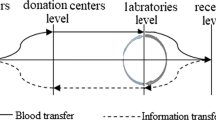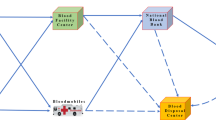Abstract
This research proposes a new tri-objective mathematical model for designing blood supply chain network in emergency situations. The mathematical model aims to minimize total supply chain costs and transportation time between facilities while maximizing total testing reliability of the donated blood in the laboratories. The model considers five echelons including blood donor groups, blood collection facilities, laboratories, blood centers and hospitals. Different transportation means with variant speed and capacity are considered in the model to carry the blood between facilities. Since, most of the main parameters of the mathematical model are tainted with uncertainty in real-world applications, two robust possibilistic flexible chance constraint programming (RPFCCP) and possibilistic flexible chance constraint programming models are developed to provide risk-averse and robust solutions to the decision makers. In addition, the application of the proposed multi-objective mathematical model is investigated in a real-world case study using real data on Iran’s capital, Tehran, which is considered to be a potential place for a destructive earthquake. Using different realizations, the applicability and efficiency of the models are investigated in the case study. The results indicated that the RPFCCP model is able to handle uncertainty in the parameters of the objective function and constraints more efficiently and is able to provide robust and risk-averse solutions for the problem which are resistant to different scenarios.







Similar content being viewed by others
References
Ahmadizadeh, M., & Shakib, H. (2004). On the December 26, 2003, southeastern Iran earthquake in Bam region. Engineering Structures, 26(8), 1055–1070.
Alizadeh Afrouzy, Z., Nasseri, S., Mahdavi, I., & Paydar, M. (2016). A fuzzy stochastic multi-objective optimization model to configure a supply chain considering new product development. Applied Mathematical Modelling, 40(17–18), 7545–7570.
Arvan, M., Tavakkoli-Moghaddam, R., & Abdollahi, M. (2015). Designing a bi-objective and multi-product supply chain network for the supply of blood. Uncertain Supply Chain Management, 3(1), 57–68.
Azad, N., Saharidis, G., Davoudpour, H., Malekly, H., & Yektamaram, S. (2012). Strategies for protecting supply chain networks against facility and transportation disruptions: An improved Benders decomposition approach. Annals of Operations Research, 210(1), 125–163.
Beliën, J., & Forcé, H. (2012). Supply chain management of blood products: A literature review. European Journal of Operational Research, 217(1), 1–16.
Ben-Tal, A., & Nemirovski, A. (1998). Robust convex optimization. Mathematics of Operations Research, 23(4), 769–805.
Cadenas, J., & Verdegay, J. (1997). Using fuzzy numbers in linear programming. IEEE Transactions on Systems, Man and Cybernetics, Part B (Cybernetics), 27(6), 1016–1022.
Cheraghi, S., & Hosseini-Motlagh, S. M. (2017). Optimal blood transportation in disaster relief considering facility disruption and route reliability under uncertainty. International Journal of Transportation Engineering, 4(3), 225–254.
Doocy, S., Daniels, A., Dooling, S., & Gorokhovich, Y. (2013). The human impact of volcanoes: A historical review of events 1900–2009 and systematic literature review. PLoS Currents, 5.
El Ghaoui, L., Oustry, F., & Lebret, H. (1998). Robust solutions to uncertain semidefinite programs. SIAM Journal on Optimization, 9(1), 33–52.
Fahimnia, B., Jabbarzadeh, A., Ghavamifar, A., & Bell, M. (2017). Supply chain design for efficient and effective blood supply in disasters. International Journal of Production Economics 183, 700–709. https://doi.org/10.1016/j.ijpe.2015.11.007.
Farrokh, M., Azar, A., Jandaghi, G., & Ahmadi, E. (2017). A novel robust fuzzy stochastic programming for closed loop supply chain network design under hybrid uncertainty. Fuzzy Sets and Systems. https://doi.org/10.1016/j.fss.2017.03.019.
Fazli-Khalaf, M., Mirzazadeh, A., & Pishvaee, M. (2017). A robust fuzzy stochastic programming model for the design of a reliable green closed-loop supply chain network. Human and Ecological Risk Assessment: An International Journal, 23(8), 2119–2149.
Hess, J. R., & Thomas, M. J. G. (2003). Blood use in war and disaster: Lessons from the past century. Transfusion, 43(11), 1622–1633.
Hosseinifard, Z., & Abbasi, B. (2017). The inventory centralization impacts on sustainability of the blood supply chain. Computers & Operations Research, 89, 206–212. https://doi.org/10.1016/j.cor.2016.08.014.
Inuiguchi, M., & Ramík, J. (2000). Possibilistic linear programming: A brief review of fuzzy mathematical programming and a comparison with stochastic programming in portfolio selection problem. Fuzzy Sets and Systems, 111(1), 3–28.
Jabbarzadeh, A., Fahimnia, B., & Seuring, S. (2014). Dynamic supply chain network design for the supply of blood in disasters: A robust model with real world application. Transportation Research Part E: Logistics and Transportation Review, 70, 225–244.
Jin, S., Jeong, S., Kim, J., & Kim, K. (2015). A logistics model for the transport of disaster victims with various injuries and survival probabilities. Annals of Operations Research, 230(1), 17–33.
Jindal, A., & Sangwan, K. (2016). Multi-objective fuzzy mathematical modelling of closed-loop supply chain considering economical and environmental factors. Annals of Operations Research. 257(1–2), 95–120. https://doi.org/10.1007/s10479-016-2219-z.
Kasperski, A., & Kulej, M. (2009). Choosing robust solutions in discrete optimization problems with fuzzy costs. Fuzzy Sets and Systems, 160(5), 667–682.
Katsaliaki, K., & Brailsford S.C. (2016). Using simulation to improve the blood supply chain. In: N. Mustafee (Ed.), Operational research for emergency planning in healthcare, (vol. 1). The OR Essentials series. London: Palgrave Macmillan.
Khalilpourazari, S., & Khalilpourazary, S. (2016). Optimization of production time in the multi-pass milling process via a Robust Grey Wolf Optimizer. Neural Computing and Applications. https://doi.org/10.1007/s00521-016-2644-6.
Khalilpourazari, S., & Khalilpourazary, S. (2017). A lexicographic weighted Tchebycheff approach for multi-constrained multi-objective optimization of the surface grinding process. Engineering Optimization, 49(5), 878–895.
Khalilpourazari, S., & Khamseh, A. A. (2017). Bi-objective emergency blood supply chain network design in earthquake considering earthquake magnitude: A comprehensive study with real world application. Annals of Operations Research. https://doi.org/10.1007/s10479-017-2588-y.
Khalilpourazari, S., & Pasandideh, S. H. R. (2016, January). Bi-objective optimization of multi-product EPQ model with backorders, rework process and random defective rate. In 2016 12th international conference on industrial engineering (ICIE), IEEE, pp. 36–40.
Kohneh, J. N., Teymoury, E., & Pishvaee, M. S. (2016). Blood products supply chain design considering disaster circumstances (Case study: Earthquake disaster in Tehran). Journal of Industrial and Systems Engineering, 9, 51–72.
Lalmazloumian, M., Wong, K., Govindan, K., & Kannan, D. (2013). A robust optimization model for agile and build-to-order supply chain planning under uncertainties. Annals of Operations Research, 240(2), 435–470.
Leo, G., Lodi, A., Tubertini, P., & Di Martino, M. (2016). Emergency department management in Lazio, Italy. Omega, 58, 128–138.
Leung, S., Tsang, S., Ng, W., & Wu, Y. (2007). A robust optimization model for multi-site production planning problem in an uncertain environment. European Journal of Operational Research, 181(1), 224–238.
Liu, B., & Iwamura, K. (1998). Chance constrained programming with fuzzy parameters. Fuzzy Sets and Systems, 94(2), 227–237.
Mole, R. H. (1975). Inventory control in hospital blood banks. Omega, 3(4), 461–473.
Nagurney, A., Masoumi, A. H., & Yu, M. (2012). Supply chain network operations management of a blood banking system with cost and risk minimization. Computational Management Science, 9(2), 205–231.
Nie, X., Huang, G., Li, Y., & Liu, L. (2007). IFRP: A hybrid interval-parameter fuzzy robust programming approach for waste management planning under uncertainty. Journal of Environmental Management, 84(1), 1–11.
Or, I., & Pierskalla, W. P. (1979). A transportation location-allocation model for regional blood banking. AIIE Transactions, 11(2), 86–95.
Osorio, A., Brailsford, S., Smith, H., Forero-Matiz, S., & Camacho-Rodríguez, B. (2016). Simulation-optimization model for production planning in the blood supply chain. Health Care Management Science, 20(4), 548–564. https://doi.org/10.1007/s10729-016-9370-6.
Pan, F., & Nagi, R. (2010). Robust supply chain design under uncertain demand in agile manufacturing. Computers & Operations Research, 37(4), 668–683.
Peidro, D., Mula, J., Poler, R., & Verdegay, J. (2009). Fuzzy optimization for supply chain planning under supply, demand and process uncertainties. Fuzzy Sets and Systems, 160(18), 2640–2657.
Phuc, P., Yu, V., & Tsao, Y. (2017). Optimizing fuzzy reverse supply chain for end-of-life vehicles. Computers & Industrial Engineering, 113, 757–765. https://doi.org/10.1016/j.cie.2016.11.007.
Pierskalla, W. P. (2005). Supply chain management of blood banks. In Operations research and health care, Springer, pp. 103–145.
Pishvaee, M., & Fazli Khalaf, M. (2016). Novel robust fuzzy mathematical programming methods. Applied Mathematical Modelling, 40(1), 407–418.
Pishvaee, M., & Razmi, J. (2012). Environmental supply chain network design using multi-objective fuzzy mathematical programming. Applied Mathematical Modelling, 36(8), 3433–3446.
Pishvaee, M., Razmi, J., & Torabi, S. (2012). Robust possibilistic programming for socially responsible supply chain network design: A new approach. Fuzzy Sets and Systems, 206, 1–20.
Ramezani, M., Kimiagari, A., Karimi, B., & Hejazi, T. (2014). Closed-loop supply chain network design under a fuzzy environment. Knowledge-Based Systems, 59, 108–120.
Şahin, G., Süral, H., & Meral, S. (2007). Locational analysis for regionalization of Turkish Red Crescent blood services. Computers & Operations Research, 34(3), 692–704.
Şahinyazan, F. G., Kara, B. Y., & Taner, M. R. (2015). Selective vehicle routing for a mobile blood donation system. European Journal of Operational Research, 245(1), 22–34.
Salehi, F., Mahootchi, M., & Husseini, S. M. M. (2017). Developing a robust stochastic model for designing a blood supply chain network in a crisis: A possible earthquake in Tehran. Annals of Operations Research. https://doi.org/10.1007/s10479-017-2533-0.
Sha, Y., & Huang, J. (2012). The multi-period location-allocation problem of engineering emergency blood supply systems. Systems Engineering Procedia, 5, 21–28.
Soleimani, H., Govindan, K., Saghafi, H., & Jafari, H. (2017). Fuzzy multi-objective sustainable and green closed-loop supply chain network design. Computers & Industrial Engineering, 109, 191–203.
Thorsen, A., & Yao, T. (2015). Robust inventory control under demand and lead time uncertainty. Annals of Operations Research, 257(1–2), 207–236. https://doi.org/10.1007/s10479-015-2084-1.
Torabi, S., & Hassini, E. (2008). An interactive possibilistic programming approach for multiple objective supply chain master planning. Fuzzy Sets and Systems,159(2), pp. 193–214.
United States Geological Survey’s (USGS). http://earthquake.usgs.gov/.
Yager, R. (1981). A procedure for ordering fuzzy subsets of the unit interval. Information Sciences, 24(2), 143–161.
Zahiri, B., & Pishvaee, M. S. (2017). Blood supply chain network design considering blood group compatibility under uncertainty. International Journal of Production Research, 55(7), 2013–2033.
Zokaee, S., Jabbarzadeh, A., Fahimnia, B., & Sadjadi, S. (2014). Robust supply chain network design: An optimization model with real world application. Annals of Operations Research, 257(1–2), 15–44. https://doi.org/10.1007/s10479-014-1756-6.
Author information
Authors and Affiliations
Corresponding author
Rights and permissions
About this article
Cite this article
Fazli-Khalaf, M., Khalilpourazari, S. & Mohammadi, M. Mixed robust possibilistic flexible chance constraint optimization model for emergency blood supply chain network design. Ann Oper Res 283, 1079–1109 (2019). https://doi.org/10.1007/s10479-017-2729-3
Published:
Issue Date:
DOI: https://doi.org/10.1007/s10479-017-2729-3




